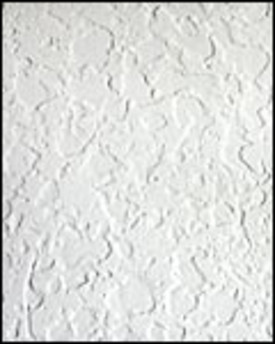 A textured wall is interesting, practical, and easy to create with ready-made products, sprayers you can buy or rent, or any variety of roll-on products. |
It used to be that the only fix for imperfect walls was wallpaper or wall repair. Imperfections, voids, dents, and dings can ruin a good paint job and take tons of time to repair. With shorter construction schedules creating pressure to finish new walls faster, there have been a whole host of improvements in the world of walls. Texturing is the new take on the old art of plastering. It’s gotten easier and less expensive, so do-it-yourselfers now have lots of options to choose from.
Traditional Plaster
On existing plaster walls, a fresh coat of plaster has always been the way to smooth out a bumpy or damaged finish. Traditional three-coat plaster jobs feature a scratch coat, a brown coat, and a finish coat. The finish coat of lime plaster can be rough, smooth, textured, or stippled. The difference lies in how rough the plaster is, how much water is added, and how the finish tools are used. A smooth wall is made with a lime plaster or a smooth-coat plaster product. It is troweled on and smoothed to ¼-inch thickness or less. Typically the plasterers work with water over the surface to wet and smooth it with a finish trowel. The finish may also be stippled with a brush to give a textured or mottled look.
Adding sand to the plaster results in a rough or textured finish. A sand coat does not set up as quickly as a traditional plaster or a molding plaster coat. It is often applied quite thick and shaped or worked with trowels, sponges, or texture pads to give the desired pattern and variation. It may also be troweled on heavily and knocked down, or smoothed to a consistent finish that remains rougher than a fine plaster finish. These plasters may also be tinted before they are applied.
Spray Textures
 Textured coatings are sprayed through an airless sprayer and splatted onto the wall like spots. Then they are knocked down with a wedge-shaped trowel to the desired surface level. |
Spray-on texture, a mix that is similar to joint compound, can be used to add texture to a wall and is DIY friendly with a little practice. Like plaster, the mix hides wall imperfections and gives a more distinctive look. Magnum Products, a Kansas-based joint compound company, produces wall finishes that are suited to level and textured finishes. Unaggregated wall finish comes as a dry mix and is blended with water to the desired consistency. Once mixed, it is loaded into an airless sprayer for application. "It’s basically joint compound in a spray form," says Jim Farley, Traffic Manager for Magnum. Products are available for purchase and sprayers can be rented or purchased at any home center.
The degree of texturing—fine, medium, or heavy—depends on the spray nozzle setting and the size of the tip. The texture mix is mixed in a pail, fed into the sprayer hopper, and then splatted onto the walls like spots. It’s best to practice on sample pieces of wallboard to get the consistency and look you desire. Once it is sprayed, the surface is knocked down with a plastic, wedge-shaped trowel or "magic knife" to even out the surface while maintaining the textured effect. The amount of water in the mix also determines the degree of texture. "The wetter it is, the more it will flatten out and smear when you take a trowel to it," says Chuck Moore, sales associate for Magnum. "There’s a little bit of an art to it," he says, noting that it’s best to work with it until you get a mix and an application system that give you the look you want.
 With traditional three-coat plaster, a finish coat is troweled on over the brown coat and smoothed to a hard shine, stippled, or textured for effect. |
Once the surface has been knocked down and the walls have set and dried, these textured surfaces can be painted like any new wall. It’s important to prime and seal all the surfaces, even in the crevices, before applying a finish coat. Moore adds that this technique is very popular in Florida and many of the popular building areas throughout the country because it’s fast, durable, and easier than taping and sanding a smooth wall for a paint finish. "It will hide a lot of sin," Moore says.
Texture Products
There are also products available to add texture to your walls. Paint and paper stores offer many ready-mix roll-on products that give a rough plaster or sand finish. Wallpapers come in a wide assortment of patterned and random textures. Companies carry anything from grass papers to textured vinyls and flocked paper. Again, texture helps to cover imperfections in walls, which makes these products popular for renovations and facelifts. There are also fiber texture products that are applied to the wall and smoothed to a consistent finish. These fiber texture mixes blend pigments and materials in one dry mix. Water is added according to package directions and it is rolled over the surface. Once dry, the textured wall provides increased sound insulation and a very distinctive look that can be easily repaired by wetting the fibrous material and smoothing over any imperfections.
Additional Resources:
- How to Patch a Textured Wall
- How to Repair a Dent in a Textured Wall Corner
- How to Clean Dried Plaster from Hardwood Floors
- How to Repair a Large Hole in Drywall
- How to Hang Drywall
- How to Tape and Finish Drywall Seams
- How to Apply Joint Compound to Drywall Corners
- How to Drive and Finish Drywall Screws
- How to Repair Chipped Corners in Drywall
- The Advantages of Drywall
Credit: Renovate Your World




























